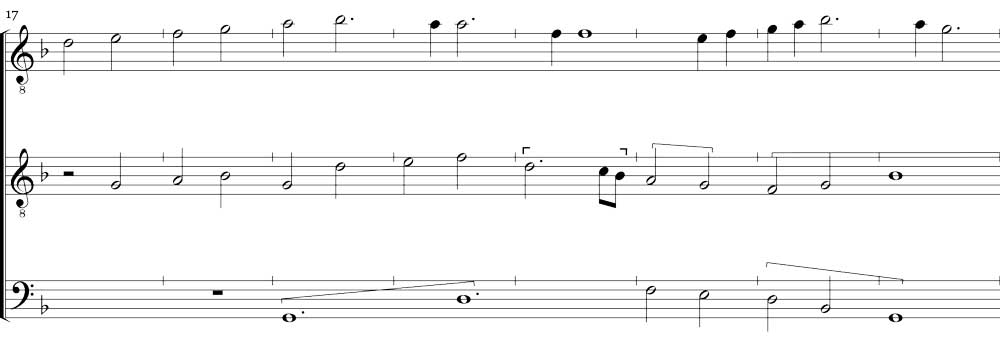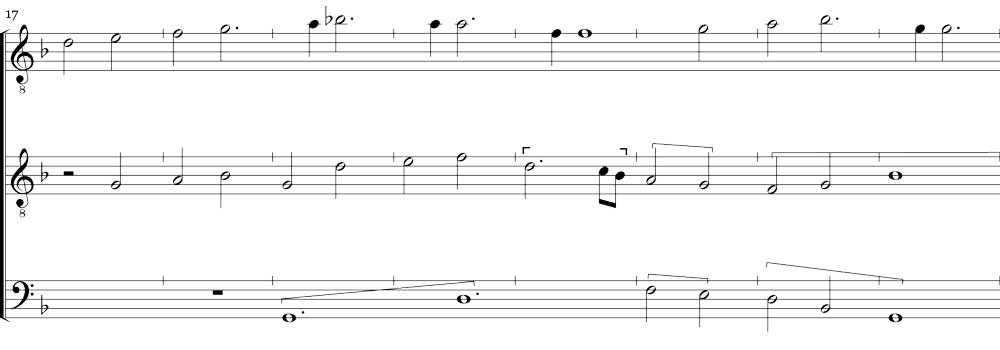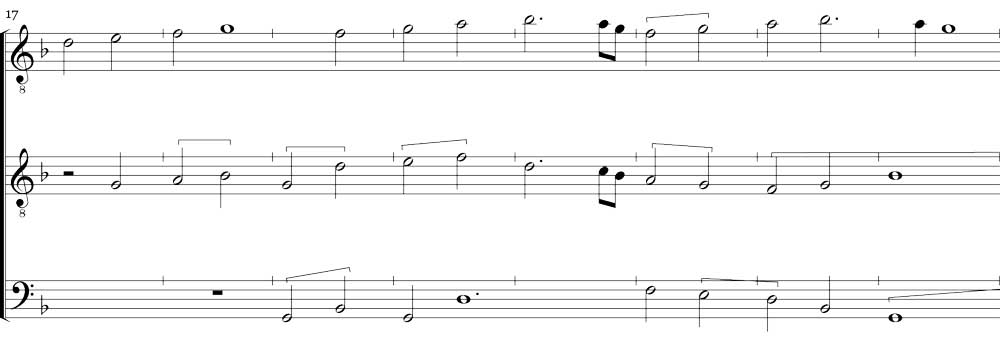Joie me fuit et douleur me queurt seure 3v ·
Busnoys, Antoine
Appearance in the group of related chansonniers:
*Dijon ff. 29v-30 »Joie me fuit et douleur me queurt seure« 3v Busnoys · Edition · Facsimile
*Laborde ff. 100v-101 »Joye me fuit et douleur me queurt seure« 3 · Edition · Facsimile
Other sources:
*Florence 176 ff. 13v-15 »Joye me fait« 3v · Edition
New Haven 91 ff. 36v-38 »Joye me fuit et douleur me ceurt seure« 3v Busnoys · Facsimile
Paris 15123 ff. 163v-164 »Oye me fayt et dolent« 3v Busnoys · Facsimile
*Rome 2856 ff. 13v-14 »Joye me fuit« 3v Busnoys · Edition · Facsimile
Trento 91 ff. 258v-259 »Je me sans« 3v Busnoys · Facsimile
This page with editions as a PDF
Reworkings, citations, and use in other compositions: see Fallows 1999, p. 227.
Editions: Droz 1927 no. 26 (Dijon); Adler & Koller 1900, p. 247 (Trento 91); Perkins 1979, vol. 1, p. 109 (New Haven 91); Busnoys 2018 no. 22 (Dijon).
Text: Rondeau cinquain; full text in Dijon and Laborde; also in Paris 1719 ff. 33v-34, Paris 7559 f. 64, ed. Bancel 1875, p. 136, Jardin 1501 f. 98.
After Dijon:
|
Joie me fuit et douleur me queurt seure, Quant je me dors lors mon esperit labeure, (4) Joie me fuit et douleur me queurt seure, Je ne scay tour si non mauldire l’eure
(5) Joie me fuit et douleur me queurt seure, |
Joy flees me, and pain pursues me, When I sleep, then my mind struggles. Joy flees me, and pain pursues me, I know of no way save to curse the hour
Joy flees me, and pain pursues me, |
In addition to minor differences in spelling, Laborde exhibits the following variants:
1) line 2, “sans riens qui me”
2) line 4, “Je me chasse …”
3) line 5, “qui longement demeure”
4) line 6, “Las quant je dors mon esperit labeure”
5) line 12, “Je n’en puis plus si …”
6) line 16, “Par quoy …”
Laborde lines 4-5, “Je me chasse loing de mon esperance / mon seul desir qui longement demeure” (I remove myself far from what I hope for, my sole desire, which remains forever).
Evaluation of the sources:
»Fors seulement l’actente que je meure« by Ockeghem and “Joie me fuit” by Busnoys were copied in the same order and after the same exemplar by the Dijon scribe into the Dijon and Laborde chansonniers on consecutive openings. In Busnoys’ song there are a few differences in their use of coloration and ligatures, and in some small errors (see the edition), but they agree on two errors in the Concordans, which come from the exemplar and are not found in the other sources: In the ligature bars 32-33.1 the second note is dotted in both manuscripts, and in bar 53 both clearly have the note E in stead of D.
Apparently, the text was difficult to read in the exemplar, because this is where the majority of the differences between the two copies crop up (see above). Moreover, the Dijon scribe in Laborde probably tried his hand at improving wrong or obscure passages, for example in line 6, which contains a syllable too much. The really difficult spot in the poem is the second half of the refrain (lines 4-5, see further below), in which the grammatical coherence is shaky. Here he in Laborde rewrote the lines and created a version different from all other sources; it is easier to grasp, but it anticipates the rime “demeure” of line 16 in a clumsy way.
It looks as if his exemplar was just as faulty and remote from the song’s origin as it was in the case of “Fors seulement”. One passage in particular was probably changed during the song’s transmission. In bar 18.1 the Dijon chansonnier has a semibrevis a’ in its upper voice, which clashes harshly with the lower voices (see ex. 1), in Laborde he simply left out this note, and in bars 22.1-23.1 a decorative passage produces a parallel octave with the Concordans (b. 22) and a stressed dissonance (b. 23.1). The version of the song, which is preserved in the slightly later chansonniers New Haven 91 (cf. Perkins 1979, vol. 1, p. 109) and Florence 176 (cf. the edition), and in other sources, is probably closer to the original version than the Dijon/Laborde version; the passage is quite straightforward in these sources (ex. 2). However, this passage must have seemed somewhat unsatisfactory at an early date. In the Ferrarese MS of the early 1480s, Rome 2856, it has been reworked into a smoother version, which also involves a change in the lowest voice (ex. 3). This is not the only reworking in the version of Rome 2856, in bars 29-30 it exhibits a more independent motion of superius, and the lowest voice has been simplified in the medial cadence (bb. 25.2-36), supporting the now parallel fifths between the upper voices with a brevis G (see further the edition).
Ex. 1, bars 17-24 after Dijon

Ex. 2, bars 17-24 after New Haven 91

Ex. 3, bars 17-24 after Rome 2856

Comments on text and music:
The stanzaic structure of this rondeau cinquain may originally have been formed as two lines plus three lines, elegantly eliding the internal division that was normal in poems intended for musical setting (3+2 lines). The tierce is clearly divided in two sentences (2+3 lines), which goes against the music’s very distinct incision after the third line (in bb. 37-38). In the two poetic collections, MS Paris 1719 and MS Paris 7559, also the refrain is structured in two plus three lines; in the wording of MS Paris 1719, f. 33v, it has: “... c’est souvenance / qui me laisse loing de mon esperance / mon seul desir est que briefment je meure.” (...is Remembering who leaves me far from what I hope for: my only desire is that soon I may die). This version (see also the edition of the song after Florence 176), in which the fourth line is a relative clause to line 3, may be the original. During the musical setting of line 3 this relationship has been severed, and a new subject “Je ne cesse” (Dijon and New Haven 91; “Je ne chasse” Laborde) has been introduced. The change fits the musical division of the setting, but obscures the meaning of the poem. In New Haven 91 also the short couplet (lines 6-8) is divided in two periods, “... au resveillier Dieu scet comment il pleure. / Lors demande de mes maulx alegance.” None of the poetic sources has this variant.
Similar to the situation in Ockeghem’s “For seulement” the poem depicts a woman deploring her unrequited love for a man. In comparison with “Fors seulement” the original poem may have been more professionally made with its elegant rimes léonines and more demanding sentence structure, which in the musical sources has become less polished. Where Ockeghem’s song featured two high voices and a low contratenor/concordans, this song is for two low voices and concordans/contratenor at an extremely low pitch. On first view the two songs look like musical opposites, but a closer look reveals an abundance of similarities (for the following, cf. the discussion of »Fors seulement«):
The poem “Joie me fuit” builds on a sequence of principal rime words ending on “-eure” similar to what we found in “Fors aeulement”: “courir seure / sequeure / meure / labeure / pleure / l’eure / saveure / demeure”. Moreover, it has been pointed out that the poem’s opening words “Joie me fuit” quote a poem by Chartier, the rondeau “Joye me fuit et desespoir me chasse” (Higgins 1987 p. 145), a male love complaint. Turning this into a female voice should then constitute a procedure similar to the relation between “Fors seulement” and Chartier’s Complainte. However, as Paula Higgins remarked (ibid.), the words “Joye me fuit” were a well-known topos, which was used by other writers, also before Chartier. “Fors seulement” and “Joie me fuit” seem to belong together, the one written as a response to the other. Which one came first, is difficult to say. “Joie me fuit” appears to be written by the more assured poet, but that probably cannot be taken as a sign of its priority.
The construction of its music is very similar to that of “Fors seulement”. The tenor is the main voice carrying the tune, which articulates the words in semibrevis notes mainly. Its tessitura is similar to Ockeghem’s tune, d-f’, when its tenor is sung in low position. The lowest voice has a wide range corresponding exactly with Ockeghem’s, an octave and a sixth, but a fifth lower, from D to bb; the upmost voice is slightly lower than Ockeghem’s, in the range of e to bb’. Tenor and superius share most of their ranges, and they often cross each other. Contra or Concordans only moves up into its highest range when the tenor rests. The openings of both sections of the rondeau are duos like in Ockeghem’s song; first between superius and contra, and in the second section the tenor comes in and takes over from the superius halfway through the duo. In both songs the tenor has a superius cadential figure with suspension and leading note in one cadence only – in Ockeghem in the final cadence, in Busnoys in the cadence after the fourth line – and the songs are of equal length, Ockeghem uses 71 breves and Busnoys 69. Furthermore, when the tenor comes in with the tune in both songs, the contra accompanies with a highly characteristic figure descending through a fourth to the lowest note of the voice, in both instances using the same rhythm consisting of a dotted semibrevis, two semiminimae, and a brevis (Ockeghem bb. 10-11, Busnoys bb. 11-12). Also the row of breves in ligature leading to the final cadence seem to be inspired by Ockeghem.
The similarities do not stop here: Busnoys’ superius and tenor are composed in perfect invertible counterpoint. It does not create any problems to sing the tenor an octave higher, every resulting fourth between the upper voices is supported by the contra. It will then have the same tessitura as Ockeghem’s tenor, and it will still change place with the superius, now in different passages. However, all sources transmit the song with two nearly equal, low upper voices. Also the uses of the tenor tune in other compositions quote the tenor in its original position, Obrecht in Missa Plurimorum carminum, “Qui tollis” (ed. Obrecht 1983, vol. 10, p. 13) and Ghiselin in Missa Joye me fuyt (Sanctus and Agnus only; ed. Ghiselin 1961, vol. 4, p. 40).
It is quite obvious that the two songs are closely related musically as well as through their poems. They may have been created in a friendly competitive air, the one as homage to the other composer, possibly in a teasing way. It is not clear-cut who instigated this exchange of songs. In his detailed discussion of the songs Vincenzo Borghetti prefers Busnoys as the first mover (see ‘Fors seulement l’actente que je meure: Ockeghem’s rondeau and the gendered rhetoric of grief’, Early Music History 31 (2012), pp. 37-85; Borghetti 2012). He writes: “... it seems likely that Fors seulement and Joye me fuit, both settings of texts derived from Chartier, were written as a kind of competition, in which, however, the younger composer was the model for the older one. My hypothesis, then, is that in view of the stylistic features listed above Fors seulement may be Ockeghem’s reply to Busnoys’s rondeau, and not vice versa – a reply in which Ockeghem displays an even more drastic use of devices typical of his colleague. In his experimental feminisation, textual and musical, of Chartier, Ockeghem in fact reaches levels of theatricality not found in Joye me fuit.”(p. 79). Surely, it is possible to argue for this interpretation, but I think that the vice versa is the more plausible solution. Let us take a look on the possibilities:
For a younger colleague in Tours it would be evident that Ockeghem had created something remarkable with his “Fors seulement”. The gimmick involving the feminine tenor based on invertible counterpoint was easy to see through, and he made his response in exactly the same way, with his tenor in the same range. Moreover, he wanted to emulate the remarkable low voice accompanying the equal voices in “Fors seulement”, and he made this relationship unambiguous by quoting the descending figure in bars 11-12, which is a distinctive feature that runs though all the voices of Ockeghem’s song. This quote – and only this quote – forced him to use the low D. This, however, had other advantages, as we shall see.
Ockeghem chose to fixate his tenor in the high position, while Busnoys apparently kept his in the normal, low position. On paper his song looks as a male companion to Ockeghem’s song making fun of the poem’s female complaint, and maybe of Ockeghem too. But everyone in these circles would know that its tenor, exactly like Ockeghem’s, could be sung an octave higher and sound quite like “Fors seulement”. However, such a performance of “Joye me fait” would still sound a bit like a travesty of Ockeghem owing to the extreme distance between tenor and contra, up to two octaves and a fifth, where Ockeghem kept his within two octaves and a third. Therefore, this was probably not the intention of Busnoys. His song is cleverly constructed in such a way that it can be performed in several combinations: As written at low pitch, secondly with the tenor sung an octave higher, and finally together with “Fors seulement” by the same group of performers consisting of a female singer or a boy on the high voice, a high male voice and a good contratenor. If his song is transposed up a fifth, into the same mode as Ockeghem’s, Busnoys’ superius and Ockeghem’s tenor share the range b-f’’; likewise, Busnoys’ tenor and Ockeghem’s superius can be sung by the same singer (a-c’’), and the contratenors both cover the range A-f’. Heard in this way, it becomes a real companion piece.
If we presume that Busnoys was the first mover and wrote his song on a rondeau by a professional poet – Busnoys seems be more aware of literary quality than many of his contemporaries –, then Ockeghem heard some new possibilities in the song. He had a poem made in the same vein, set it for the same selection of voices a fifth higher using the same characteristics, only more clearly profiled, and he decided on the octave transposition of the tenor. He also developed the descending figure at the start of Busnoys’ contratenor into a memorable feature colouring his whole song. This relationship between the two songs is of course possible as Borghetti proposes, but it leaves Busnoys’ song curiously orphaned. It is difficult to explain the very low pitch of its contratenor, if it does not emulate Ockeghem. Busnoys could have kept it within a normal range and still avoided crossing above the tenor. Ockeghem, on the other hand, had to place his contra where he did in order to have it fulfil its duties below the invertible counterpoint.
I think that we have to regard Ockeghem’s “Fors seulement” as the original song. “Joye me fuit” by Busnoys was a clever response to Ockeghem, demonstrating that a wider palette of sound was possible within the framework set out by Ockeghem. This view does not detract anything from the issues of gender revealed in these songs as discussed by Borghetti, but it emphasizes the composer’s exploration of and play with the possibilities presented by the low contratenor in the three-voice chanson in the 1460s. The double chanson »Fors seulement contre ce qu’ay / Fors seullement l’actente« may in this connection be Ockeghem’s reaction to Busnoys’ move.
PWCH July 2016